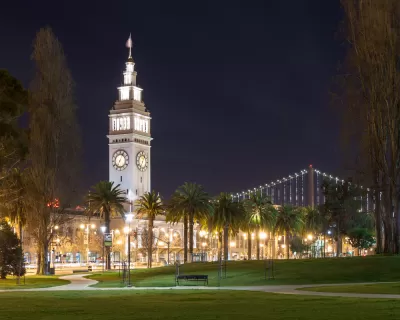C.W. Nevius examines the consequences of Proposition B—on the ballot in San Francisco in June.

Who put Art Agnos in charge?" asks C.W. Nevius in a recent column about the impending citywide vote on Proposition B, which would require an election for all projects exceeding the city's current 40-foot height limit along the waterfront. "It seems that if Proposition B passes next month, as most think it will, Agnos will become the unofficial potentate of the waterfront. Virtually every project developer will have to go to the former mayor…on bended knee to ask for a blessing."
"Agnos will tell you that this isn't going to be a problem, that projects just have to conform to existing height limits," writes Nevius. The problem? "That's not going to pencil out financially. As the analysis found, low-rise development on the land 'is not economically feasible.' So expect either an endless round of height-limit elections or a chilling effect on potential projects."
Nevius goes on to mention that Proposition B is a political third rail for local politicians—describing City Hall's take on the initiative as a vacuum.
Then there's the threat of legal action should Proposition B pass: "And even if it passes, there will almost certainly be a legal challenge. Waterfront land has been under the jurisdiction of the California State Lands Commission since 1850. The idea that a city is circumventing state authority will be fodder for a lawsuit."
FULL STORY: Ex-Mayor Art Agnos emerges as waterfront power broker

Maui's Vacation Rental Debate Turns Ugly
Verbal attacks, misinformation campaigns and fistfights plague a high-stakes debate to convert thousands of vacation rentals into long-term housing.

Planetizen Federal Action Tracker
A weekly monitor of how Trump’s orders and actions are impacting planners and planning in America.

In Urban Planning, AI Prompting Could be the New Design Thinking
Creativity has long been key to great urban design. What if we see AI as our new creative partner?

King County Supportive Housing Program Offers Hope for Unhoused Residents
The county is taking a ‘Housing First’ approach that prioritizes getting people into housing, then offering wraparound supportive services.

Researchers Use AI to Get Clearer Picture of US Housing
Analysts are using artificial intelligence to supercharge their research by allowing them to comb through data faster. Though these AI tools can be error prone, they save time and housing researchers are optimistic about the future.

Making Shared Micromobility More Inclusive
Cities and shared mobility system operators can do more to include people with disabilities in planning and operations, per a new report.
Urban Design for Planners 1: Software Tools
This six-course series explores essential urban design concepts using open source software and equips planners with the tools they need to participate fully in the urban design process.
Planning for Universal Design
Learn the tools for implementing Universal Design in planning regulations.
planning NEXT
Appalachian Highlands Housing Partners
Mpact (founded as Rail~Volution)
City of Camden Redevelopment Agency
City of Astoria
City of Portland
City of Laramie



























